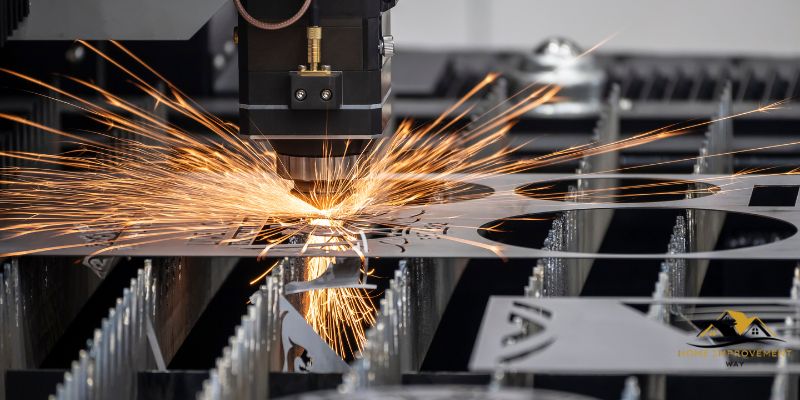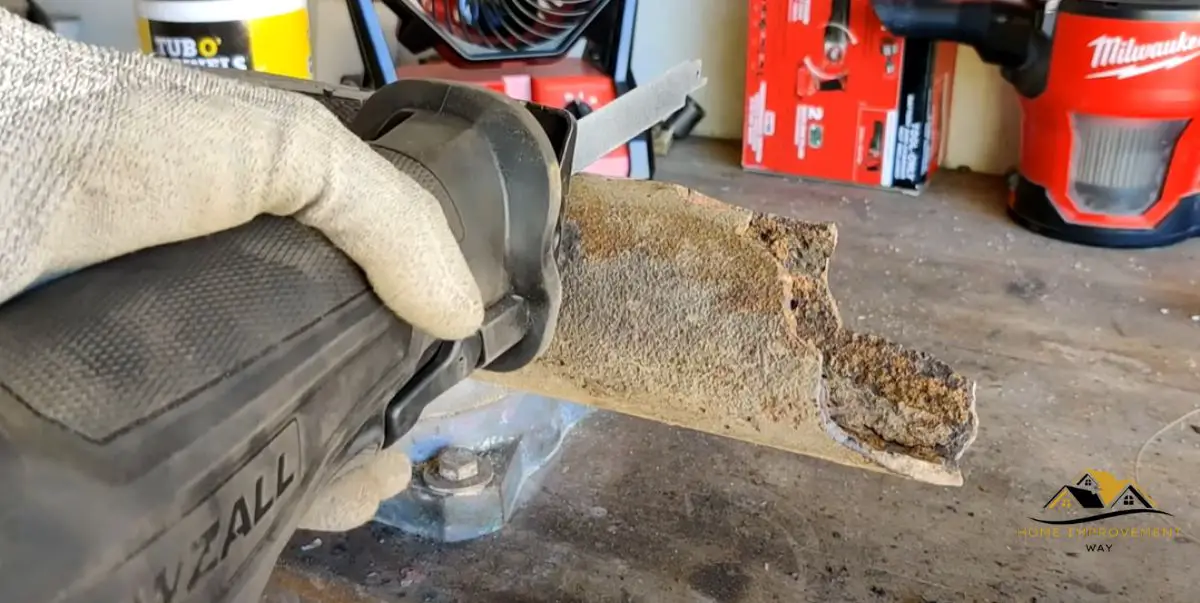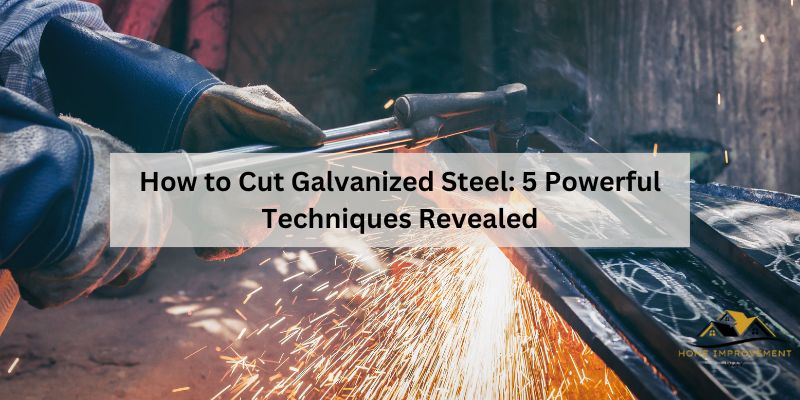To cut galvanized steel, use a grinder with a cutting wheel. Now let’s dive into the process of cutting galvanized steel in more detail.
Galvanized steel is a popular and durable material used in various construction and DIY projects. However, cutting galvanized steel requires proper technique and tools to ensure a clean and precise cut. One effective method is to use a grinder with a cutting wheel specifically designed for metal.
The cutting wheel’s abrasive surface allows it to slice through the galvanized coating and the steel underneath. Remember to wear protective gear, such as safety glasses and gloves, and take necessary precautions to prevent sparks, as cutting galvanized steel can generate intense heat.
Understanding Galvanized Steel
Before delving into the process of cutting galvanized steel, it’s crucial to understand what galvanized steel is and its properties. Galvanized steel is a type of steel that has been coated with a layer of zinc to protect it from corrosion. This coating creates a barrier that prevents moisture and other elements from reaching the underlying steel. Galvanized steel is widely used in various industries due to its durability and resistance to rust.
What Is Galvanized Steel?
Galvanized steel is a common material used in construction, manufacturing, and other applications. It is produced by immersing steel into a molten bath of zinc, which forms a protective layer on the surface. This process, known as galvanization, results in steel that has enhanced corrosion resistance properties. The zinc coating helps protect the steel from rust caused by exposure to moisture, chemicals, and other environmental factors.
Properties Of Galvanized Steel
Galvanized steel possesses several essential properties that make it a preferred choice in many industries. These properties include:
- Corrosion Resistance: The zinc coating on galvanized steel provides excellent protection against corrosion, extending the lifespan of the material.
- Durability: Galvanized steel is highly durable and can withstand harsh weather conditions, making it suitable for outdoor applications.
- Strength: Galvanized steel is known for its strength, making it suitable for structural purposes.
- Cost-Effectiveness: Considering its long lifespan and low maintenance requirements, galvanized steel offers a cost-effective solution for various projects.
- Easy Weldability: Galvanized steel can be easily welded, allowing for seamless integration into different structures and components.
With these properties, galvanized steel proves to be a versatile material that can withstand the test of time in various applications. Now that we have a better understanding of galvanized steel, let’s explore how to cut it effectively.

Safety Precautions
When cutting galvanized steel, it’s essential to prioritize safety. By taking the necessary precautions, you can prevent accidents and ensure a successful and efficient cutting process. We have outlined several safety measures below that you must adhere to.
Wear Safety Gear
Before you start cutting galvanized steel, it’s crucial to put on the appropriate safety gear. This will protect you from potential hazards and injuries. Make sure to wear:
- Safety goggles: Protect your eyes from sparks, debris, and metal particles that may fly during the cutting process.
- Heavy-duty gloves: Shield your hands from sharp edges and any molten metal.
- Ear protection: Use earplugs or earmuffs to minimize the impact of loud noises produced during the cutting.
- Respiratory mask: Prevent the inhalation of harmful fumes and dust particles by wearing a mask specially designed for this purpose.
Set Up A Safe Work Area
Creating a safe work area is crucial to ensure the successful cutting of galvanized steel. Follow these steps to set up a safe environment:
- Clear the space: Remove any unnecessary objects that may cause tripping hazards or obstruct your movements.
- Work in a well-ventilated area: Ensure there is proper air circulation to reduce the concentration of potentially harmful fumes.
- Secure the workpiece: Use clamps or vices to firmly secure the galvanized steel, preventing it from moving during the cutting process.
| Tip: | Always position the galvanized steel on a stable, non-slip surface. |
|---|
By following these safety precautions, you can confidently embark on your galvanized steel-cutting project, minimizing any risks involved. Remember, safety should always be your top priority!
Techniques For Cutting Galvanized Steel
Cutting galvanized steel may seem like a daunting task, but with the right techniques and tools, it can be done effectively and efficiently. In this article, we will explore four popular methods for cutting galvanized steel: using a circular saw, using an angle grinder, using tin snips, and using a plasma cutter. Each method has its advantages and considerations, so let’s dive in and discover which technique suits your needs best.
Using A Circular Saw
One of the most popular methods for cutting galvanized steel is using a circular saw. This versatile tool allows for precise and straight cuts, making it ideal for larger projects. To cut galvanized steel with a circular saw, you’ll need a metal-cutting blade designed specifically for cutting through this tough material. These blades typically have carbide teeth that can withstand the abrasiveness of galvanized steel.
- Ensure you have the appropriate safety equipment, including safety glasses and gloves.
- Secure the galvanized steel sheet firmly in place using clamps or a workbench.
- Set the depth of the circular saw blade just deep enough to cut through the galvanized steel.
- Position the saw blade on the marked cutting line and activate the saw.
- Move the circular saw slowly along the cutting line, allowing the blade to cut through the galvanized steel.
- Continue cutting until the desired length or shape is achieved.
Using An Angle Grinder
An angle grinder is another powerful tool commonly used for cutting galvanized steel. It offers the advantage of versatility, allowing you to make both straight and curved cuts easily. To cut galvanized steel with an angle grinder, you’ll need an abrasive cutting disc designed for metal cutting. These discs are available in various sizes and thicknesses to suit your specific needs.
- Ensure you have the appropriate safety equipment, including safety glasses and gloves.
- Secure the galvanized steel sheet firmly in place using clamps or a workbench.
- Attach the metal cutting disc to your angle grinder, making sure it is properly tightened.
- Position the angle grinder on the marked cutting line and activate it.
- Gently guide the angle grinder along the cutting line, allowing the cutting disc to gradually cut through the galvanized steel.
- Move the angle grinder in a steady motion until the desired length or shape is achieved.
Using Tin Snips
Tin snips, also known as aviation snips, are hand tools designed specifically for cutting through sheet metal, including galvanized steel. They are perfect for making precise and intricate cuts in smaller galvanized steel pieces. Tin snips come in several types, including straight-cut, left-cut, and right-cut, allowing for different cutting directions and angles.
- Ensure you have the appropriate safety equipment, including safety glasses and gloves.
- Secure the galvanized steel sheet firmly in place using clamps or a workbench.
- Choose the appropriate tin snips based on your desired cutting direction.
- Position the tin snips on the marked cutting line and apply consistent pressure to cut through the galvanized steel.
- Gently move the tin snips along the cutting line, following the desired shape or pattern.
- Continue cutting until the desired length or shape is achieved.
Using A Plasma Cutter
A plasma cutter is a high-powered tool that uses an electrical arc to cut through various types of metal, including galvanized steel. This method is ideal for thicker galvanized steel sheets and offers precise and clean cuts. However, plasma cutters can be expensive and require proper training and safety precautions.
- Ensure you have the appropriate safety equipment, including safety glasses, gloves, and a face shield.
- Secure the galvanized steel sheet firmly in place using clamps or a workbench.
- Prepare and set up your plasma cutter according to the manufacturer’s instructions.
- Position the plasma cutter torch on the marked cutting line.
- Activate the plasma cutter and move it along the cutting line, allowing the high-temperature plasma to melt through the galvanized steel.
- Continue cutting until the desired length or shape is achieved.
By utilizing these techniques for cutting galvanized steel, you can successfully complete your projects with precision and efficiency. Remember to prioritize safety by wearing the appropriate protective gear and following safety guidelines for each cutting method. Choose the method that aligns with your project requirements, and enjoy the satisfaction of achieving clean and accurate cuts in galvanized steel.
Tips For Successful Cuts
When it comes to cutting galvanized steel, selecting the right tools and techniques is crucial for achieving clean and precise cuts. This section will present valuable tips and tricks that will help you make successful cuts on galvanized steel.
Choosing The Right Blade
Choosing the appropriate blade is the first step to successfully cutting galvanized steel. The blade you use should be specifically designed for cutting metal, as regular wood or masonry saw blades will not be effective. Opt for a blade with a high tooth count and made from carbide, as it will deliver clean and precise cuts with minimal rough edges.
Marking The Steel
Prior to making any cuts, it is essential to mark the steel accurately. This will help you maintain a straight cutting line and prevent mistakes or unnecessary waste. Use a permanent marker or soapstone to mark the desired cutting line. Remember to double-check the measurements to ensure accuracy before proceeding with the cut.
Applying Steady Pressure
Applying steady pressure is vital when cutting galvanized steel. Use a vise or clamp to hold the material securely in place, providing stability throughout the cutting process. Make sure to position the steel in a way that allows you to apply consistent pressure as you follow the marked cutting line.
When using a power tool, such as an angle grinder or circular saw, it is important to maintain a firm grip on the tool while applying steady pressure on the steel. Keep the tool steady and move it smoothly along the cutting line to ensure a smooth and accurate cut.
Remember, patience is key when cutting galvanized steel. Rushing through the process can result in uneven cuts and jagged edges. Take your time, follow the proper techniques, and apply steady pressure. By doing so, you can achieve clean and precise cuts on galvanized steel without difficulty.

Finishing And Cleaning
After successfully cutting galvanized steel, your work is not complete. You must give attention to the finishing and cleaning process to ensure a polished and rust-free outcome. This section will guide you through the essential steps of removing burrs and protecting against rust.
Removing Burrs
When cutting galvanized steel, burrs are an inevitable result. These sharp edges and protrusions can not only be unsightly but can also pose safety hazards. To remove them effectively, follow these steps:
- Inspect the cut edges: Before starting the deburring process, carefully examine the cut edges for any burrs or rough spots.
- Choose the right tool: Depending on the severity of the burrs, you can use various tools such as a file, a deburring tool, or sandpaper.
- File the edges: If the burrs are larger, use a file to smooth them out. Apply light pressure and work in a single direction to avoid further damage.
- Deburr with a deburring tool: For smaller burrs or harder-to-reach areas, a specialized deburring tool can be useful. Follow the manufacturer’s instructions for proper usage.
- Finish with sandpaper: After the initial deburring, use fine-grit sandpaper to further smooth the edges. This will ensure a clean finish and remove any remaining roughness.
Protecting Against Rust
Galvanized steel is known for its resistance to corrosion, but proper care is still necessary to maintain its protective coating. Here are steps you can take to protect your cut galvanized steel from rust:
- Remove any debris: Thoroughly clean the cut area to remove any metal shavings or dirt that can accelerate rusting.
- Apply a rust inhibitor: Using a rust inhibitor spray or solution, coat the cut edges to create an additional barrier against corrosion.
- Add a protective coating: Consider applying a protective sealant or paint to further enhance the steel’s resistance to rust. This extra layer acts as a shield against moisture and oxygen.
- Maintain regular inspections: Periodically check the cut galvanized steel for any signs of rust or damage. Addressing any issues promptly will help prevent the spread of corrosion.
Conclusion
Cutting galvanized steel may seem daunting at first, but with the right tools and techniques, it can be easily done. By following the steps outlined in this blog post, you’ll be able to cut galvanized steel efficiently and effectively. Remember to prioritize safety by wearing protective gear and using the correct cutting tool for the job.
With practice and patience, you’ll become adept at cutting galvanized steel in no time. Happy cutting!


